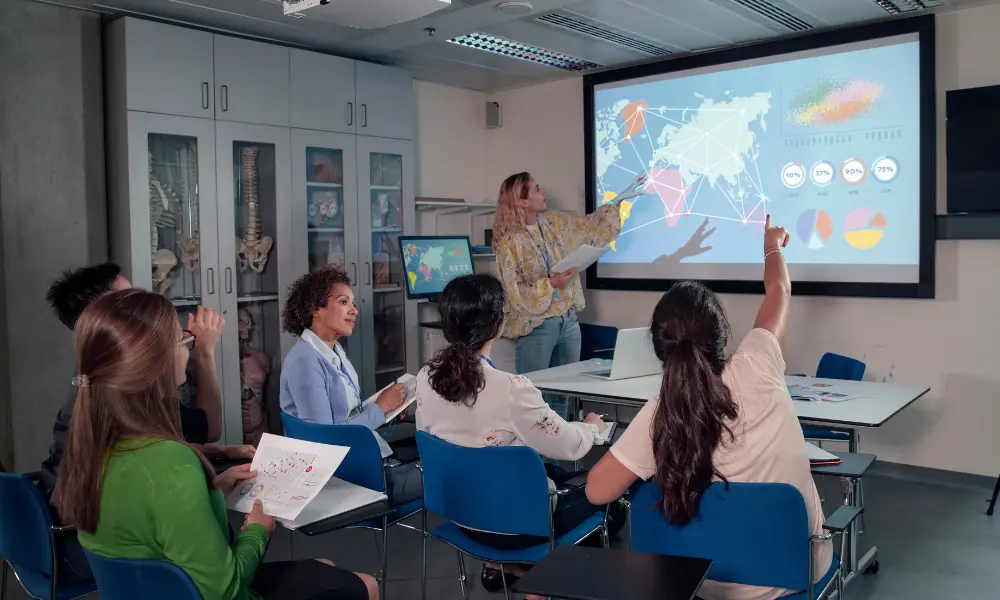An engaged student is a happy learner. As education continually evolves, the shift towards new and personalized approaches has become increasingly imperative. Recent studies have shown that 92% of teachers consider student engagement as a key driver of success. This resonates with the contemporary shift towards student-centric approaches. The surge in popularity of student-centric models is rooted in the recognition that a one-size-fits-all approach no longer suffices. In traditional teaching methods, the teacher takes center stage to disseminate information, disregarding individual learning styles. However, student-centric approaches place learners at the heart of the educational journey. Recognizing this, School Management Systems (SMS) emerge as a pivotal force in shaping modern educational experiences. These systems are equipped with advanced technologies and data-driven insights to tailor content to students’ interests and provide personalized feedback. They seamlessly integrate administrative tasks, empower educators with valuable resources, and provide students with personalized learning opportunities. This guide aims to assist all stakeholders through the intricate process of creating a student-centric environment with the aid of SMS.
1. Personalized Learning Paths
School Management Systems function as dynamic tools that empower educators to tailor learning experiences for flexibility and adaptability. The technology compiles data from various assessment sources, and through intuitive interfaces and analytics tools, educators can identify specific strengths and weaknesses. This granular analysis allows for a nuanced understanding of each student’s learning profile. The incorporation of adaptive learning algorithms within SMS assesses individual student progress and adjusts the difficulty and pace of learning materials accordingly. Additionally, the system provides educators with tools to create personalized assignments to accommodate different learning styles, individual preferences, and proficiency levels. This not only promotes a more meaningful connection between the student and the subject matter but also encourages a sense of ownership over the learning process. The University of Murcia in Spain implemented an AI chatbot that enhanced personalized learning by providing immediate assistance and leveraging data for innovative educational improvements.

2. Interactive and Adaptive Learning Resources
Educators can seamlessly embed videos, interactive simulations, podcasts, and other multimedia elements into their curriculum. This diverse range of materials caters to different learning modalities, ensuring that students with varying preferences and strengths find the content engaging and comprehensible. School Management Systems also facilitate the integration of animated lessons and simulations, transforming the learning experience into an interactive and immersive journey. For example, in a physics class, educators can use animated lessons to illustrate principles like gravity or electromagnetism. The intuitive interfaces provided by these systems simplify the process of content creation. What’s more, an educator can easily design a quiz, develop a presentation, or structure a lesson plan through drag-and-drop features and customizable templates. This intuitive approach saves time and encourages educators to experiment with diverse content creation.
3. Efficient Communication Channels
Communication serves as a vital link in the relationships among students, teachers, and parents. SMS communication features play a key role in creating a collaborative and transparent educational environment. These systems provide a platform for timely and meaningful exchanges. Educators actively share updates on academic progress, assignments, and achievements. Students use the system to seek clarification and engage in collaborative activities. Parents, seamlessly integrated into the educational journey, receive real-time updates on their child’s performance and overall well-being. Efficient communication channels become the cornerstone of creating a cohesive, supportive, and student-centric educational community.
4. Data-Driven Decision-Making
SMS is equipped with robust data-driven insights to assist educators in making informed decisions. They are adept at collecting a diverse range of data pertaining to student activities and academic performance. This encompasses basic demographic information, attendance records, grades, assessment results, and engagement metrics. The collected data within SMS serves as a treasure trove for understanding the student. For example, the system tracks a student’s regularity and punctuality, helping identify trends and potential concerns. The engagement metrics may include participation in class activities, interactions with learning materials, and contributions to group projects. In addition, SMS ensures the confidentiality and integrity of student information by implementing stringent protocols to safeguard sensitive data. Encryption, secure authentication processes, and restricted access mechanisms are integral components.

5. Streamlined Administrative Processes
Administrative tools embedded within School Management Systems simplify and expedite various processes. Enrollment procedures are streamlined through automated forms and centralized databases, reducing paperwork and enhancing accuracy. Furthermore, grading becomes more efficient with automated grading systems that swiftly process and organize assessment results. This allows educators to focus on providing timely feedback. The efficiency of resource allocation in the SMS helps manage inventory, track resource utilization, and facilitate seamless communication between departments. Moreover, these systems facilitate communication among administrative staff, promoting a culture of collaboration and ensuring cohesive decision-making. The outcome is a learning environment where administrative tasks seamlessly integrate with the overarching goal of student-centric education.
Classter: Empowering Student-Centric Education
Classter’s School Management System stands as an easy-to-use, fully customizable tool to transform educational institutions into student-centric environments. With an intuitive interface and a powerful Curriculum Builder, Classter empowers educators to craft engaging academic experiences tailored to individual learning needs. The system’s robust commitment to secure data management, hosted on MS Azure, ensures compliance with GDPR. Additionally, a key feature enhancing student-centricity lies in Classter’s detailed student records. Educators gain quick access to a wealth of information, spanning academic performance, personal details, and medical records. Equally as important, is seamless integrations with popular third-party tools, including Office 365, Google Workspace, and Moodle, along with the Open Web API. This allows for collaboration and provide a holistic view of student progress. Classter’s School Management System transcends traditional administrative functions. It actively contributes to the creation of student-centered educational ecosystems that prioritize personalization, support, and enrichment.
The Gist
The amalgamation of technology, data-driven insights, and seamless communication facilitated by SMS has redefined education. With continual advancements, these systems are anticipated to respond to the evolving needs of diverse learners. The personalized learning paths forged by School Management technologies will not only empower educators but also unlock the full potential of every student. This transformative evolution heralds a future where education is reshaped by innovative tools and inherently responsive to the individualized journey of each learner.
FAQ’s
Personalized learning paths tailored to individual student needs enhance engagement, promote ownership over the learning process, and improve academic outcomes.
Use a Student Management System to tailor learning experiences, integrate interactive resources, facilitate efficient communication, make data-driven decisions, and streamline administrative processes.
Yes, Classter’s intuitive interface, Curriculum Builder, secure data management on MS Azure, detailed student records, and seamless integrations ensures personalized education.

